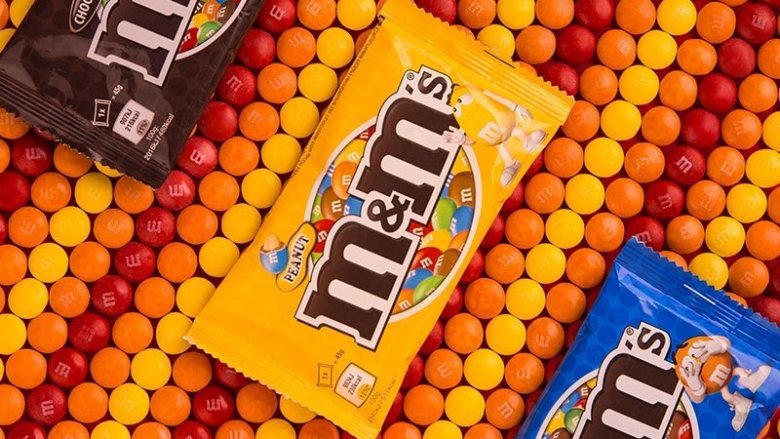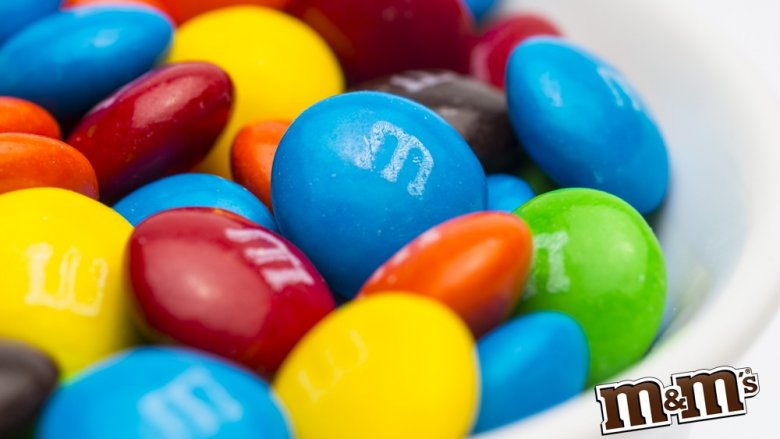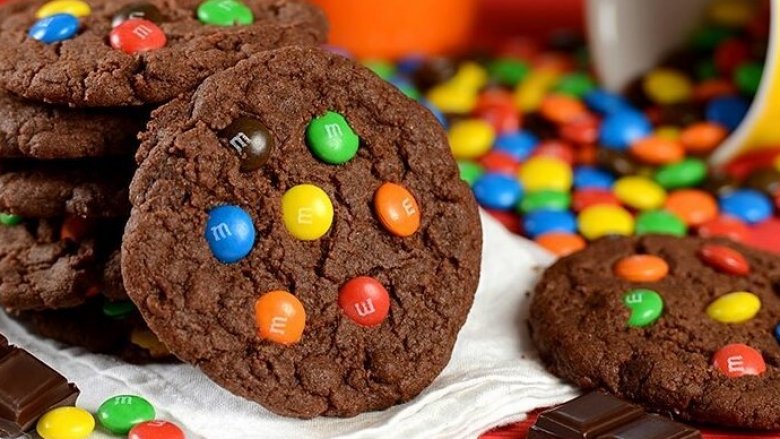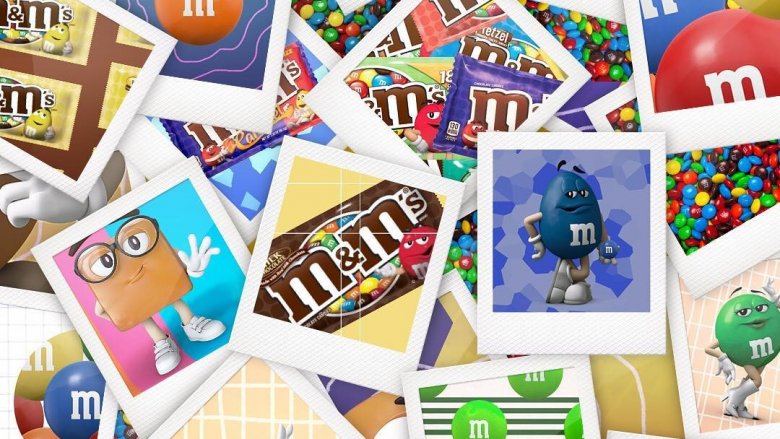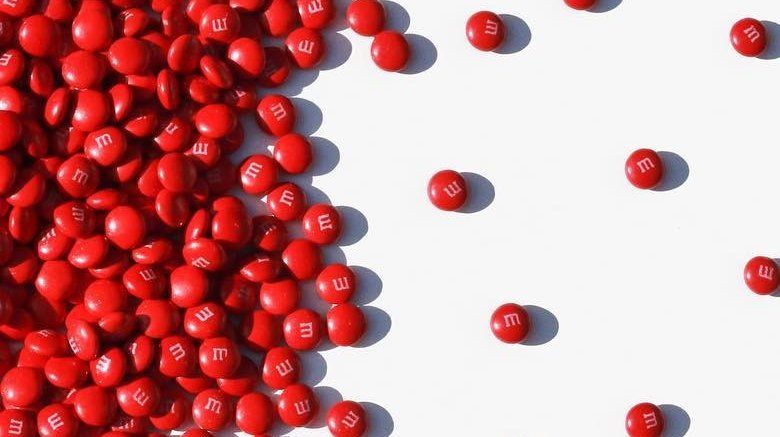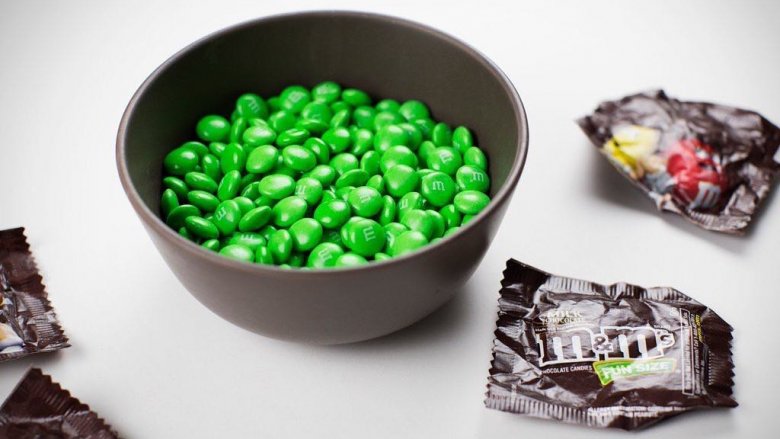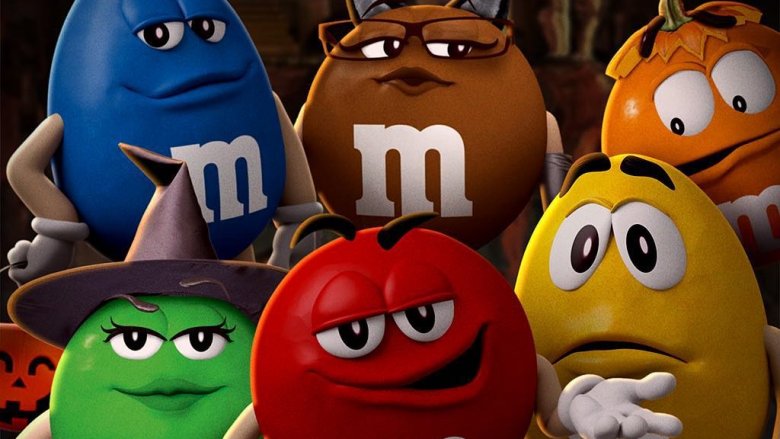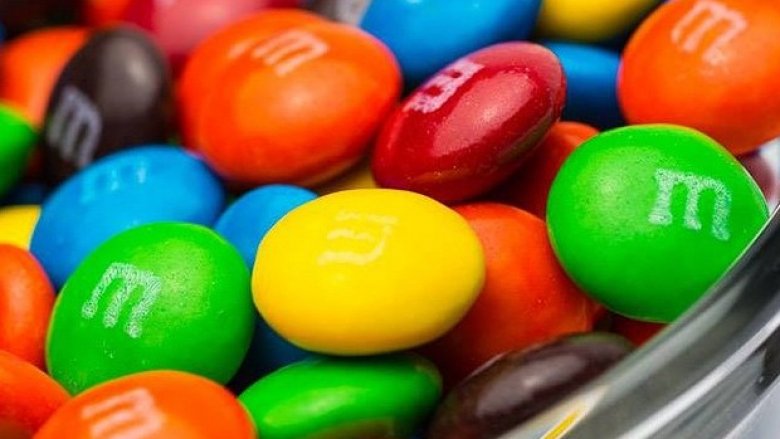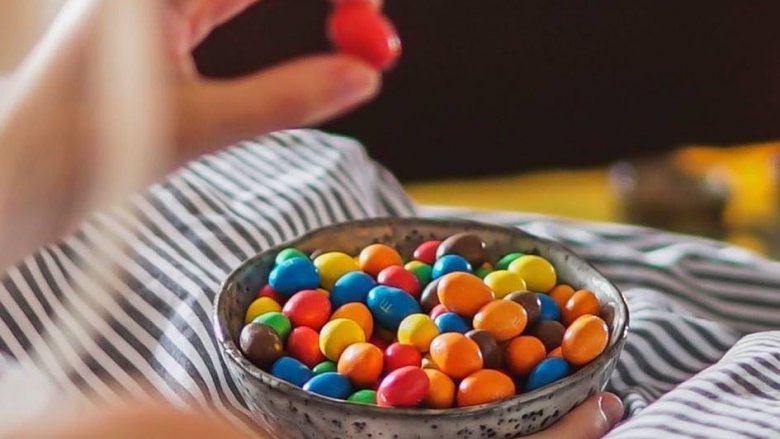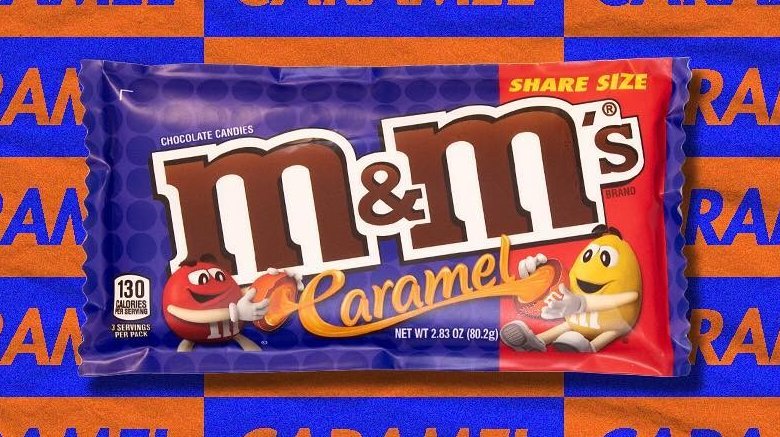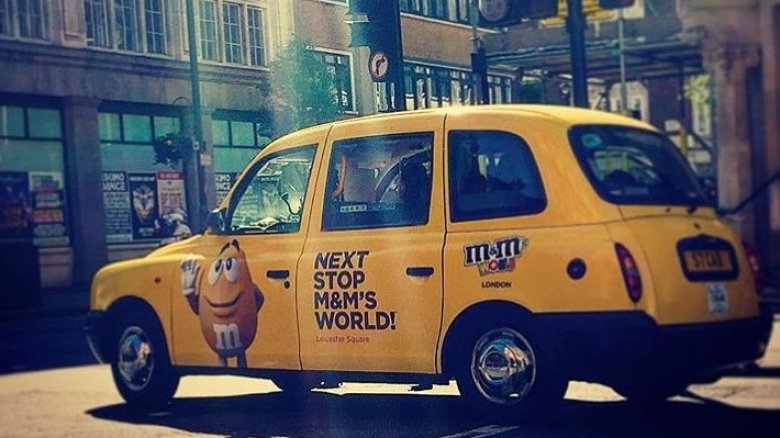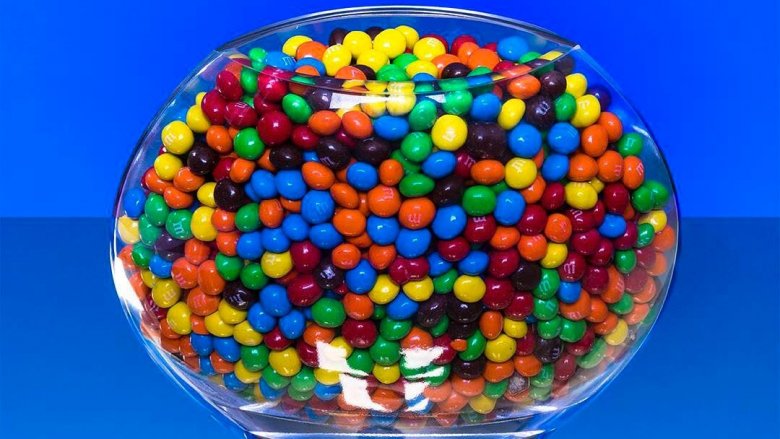The Shady Side Of M&M's
Everyone loves M&M's, so much so that it's not uncommon for an entire party-size bag to be eaten in a single sitting. Whether you mix colors or separate them, prefer milk chocolate, peanut, or one of the fancy new varieties, everyone has their favorite. (Fun fact: Peanut definitely wasn't the favorite of M&M's creator Forrest Mars. According to the Farmers' Almanac, he was severely allergic to peanuts.)
Less well-known than M&M's severely addicting quality is the fact that their history is just as colorful as they are. It's punctuated by some strange things indeed, and not all of it is nice. There's an overbearing, demanding creator, not a little bit of outright theft, some seriously uncomfortable sexism, a bizarre lawsuit, and those rumors about the green M&M's have been around longer than you think. The candy might be completely family-friendly, but the story behind it isn't the kind of example you'd want to set for your kids.
They're a total rip-off
According to Nestle UK Archivist Alex Hutchinson, the idea of little bits of chocolate — like you get inside an M&M — are actually some of the first known chocolate sweets. They were called crottes du lapin, and the name's translation refers to what the little chocolate balls look like: rabbit poop.
You can't un-know that, and here's something else you can't unknow. Chocolate was something of a luxury, but when Georgian ladies ate them, they smeared their white gloves. Confectioners added a sugar shell to keep that from happening — that sounds familiar, doesn't it?
In the 1880s, Nestle was known as H.I. Rowntree & Co., and they were already making these candy-covered chocolate bits, according to Hutchinson. By the 1930s, they were marketing Chocolate Lentils, which became Chocolate Beans, and eventually became Smarties. That brings us to M&M's. Creator Forrest Mars, Sr., was in Spain in 1937, and may have been hanging out with Rowntree's George Harris. The Guardian says there are a few different versions of exactly what happened, but essentially, Mars saw Rowntree's Smarties... and then headed back to the US to "invent" M&M's.
The M placement is a huge deal
When The New York Times ran a story with news of creator Forrest Mars, Sr.'s passing in 1999, it was a bit of an odd obituary. Mars — and the rest of his family — were maniacally reclusive, and he was as noted for his temper as for his candy. He docked the pay of employees who were late (and rewarded those who showed up on time), and even micromanaged things down to the neatness of employees' desks.
Mars subscribed to the idea that everything needed to be neat and orderly... even each individual M&M. The man who was known for once grabbing a basket of papers off a senior exec's desk and hurling the whole thing across the room was also known for making late-night calls after he'd been examining new batches of M&M's. If the "M" wasn't in the precise center, he would recall the entire lot — and he wasn't afraid to call people in the middle of the night and wake them up to tell them what he'd found. After his retirement in 1973 his sons took over as co-presidents... but he continued to make his phone calls and tell them when they slipped up.
The other M stands for something surprising
There are a few candy giants in the industry today, and as The New York Times says, Hershey and Mars are "archrivals." That's what makes it so weird that while one of the Ms of M&M's is for Forrest Mars, the other is for Hershey's Bruce Murrie. Milton Hershey — one of industry's great philanthropists — promoted Bruce's father, William Murrie, from salesman to general manager early on in the company's history, and he oversaw the relationship between Hershey and the companies Hershey supplied with chocolate — including Mars.
The entire country was facing a chocolate shortage leading up to World War II, and that's when Forrest Mars stepped up and approached Bruce Murrie and Hershey who, notes Mental Floss, had worked out a deal to provide chocolate for the military. Mars struck up a deal with Murrie to create M&M's as a joint effort. We still call them M&M's, but as soon as the war ended, so did the partnership. Mars "maneuvered" Murrie out, says Hershey Archives, and became one of Hershey's main competitors.
The red dye scare
Red is one of the staple colors that comes in a pack of M&M's today, and he's also one of the spokescandies featured in M&M's commercials. But for more than a decade — between 1976 and 1987 — there were no red M&M's for a pretty strange reason.
According to LiveScience, they were originally removed because of a mass panic caused by a Russian study that linked a dye called FD&C Red No. 2 with cancer. When the FDA confirmed the link it was banned, and red M&M's disappeared.
But here's the weird thing. Red M&M's never actually contained Red No. 2. The LA Times says it was two other types of red dye — No. 3 and No. 40 — that were used, and both were completely safe. Mars was worried consumers wouldn't buy anything dyed red in the years surrounding the scare, and it was only when they started getting letters from people yearning for the nostalgia of red M&M's that they finally reintroduced them.
Green has a sordid past
Snopes says when red M&M's disappeared, there was actually a (false) rumor they were such a powerful aphrodisiac that employees were stealing them. But when it comes to aphrodisiac candies, most of us have heard the rumors about the green ones — supposedly, they're the candies that really put you in the mood for love.
They're not sure where the rumors started, but it likely began with students in the 1970s, who gave green M&M's to their crushes. Mars is well aware of the rumors, and they've had sort of an odd relationship with them. In the early 1990s, Mars sued the owner of Cool Chocolates, Inc. for making an M&M-like product called Green Ones. In addition to trademark infringement, The New York Times said Mars also had an issue with the implication there was something less-than-wholesome about their product.
A few years later, Mars did a complete 180 and decided to cash in on the aphrodisiac rumors with the creation of a weirdly sexualized Ms. Green spokescandy. Business Insider says the spokescandies were created to help struggling sales, and when their green campaign started asking, "Is it true what they say about the green ones?" it became pretty clear they weren't as worried about their wholesome image as they had been.
They've been accused of being sexist
Chocolate has been linked with Valentine's Day for a long time, but Mic argues there's something not just sexy going on here, but sexist. They start with Ms. Green's go-go boots, which were given to her because the original ad team couldn't figure out a way to draw her with appropriately sexy legs. That's... weird. Ms. Green was the only female spokescandy for a pretty shocking 17 years, and it wasn't until 2012 the group got a smart female character... who just happens to also be the bossy one. Meanwhile, Jezebel called Ms. Green's Sports Illustrated Swimsuit Edition-inspired commercial proof that sexist advertising was alive and well in the 21st century.
NYU professor Jennifer Berg says it's pretty obvious how those two can be interpreted as sexist, but adds that the male characters are just as sexist because of the traits they're defined by. Red? He thinks he's smarter than he is. Yellow? He's run by his "inner child." Orange is the stressed-out one suffering from extreme paranoia, and Blue is the super-cool, super-fit one. Berg says they're "deprecating male characteristics ... [and] benign, sanitized versions of male traits" that serve to make them endearing.
They're banned in Sweden
Mars is an international giant, but they've run into their share of lawsuits and conflict. The Local SE did a quick recap on their rocky relationship with another candy company in Sweden, one-time partner Mondelez International. Mondelez partnered with Mars in the 1950s, and the two launched a line of candies called M. For decades, everything was pretty much status quo.
Fast forward a bit, and the two agreed Mars wouldn't bring M&M's into Finland, Norway, or Sweden because it would just be competition. The agreement wasn't renewed, and M&M's showed up in Sweden in 2009. Two years later they were in court on grounds of trademark infringement, and according to the BBC, in 2016 courts ruled the lower case version of m&m was too close to the Marabou M for comfort. Mars protested, but Sweden took it so seriously they banned sale of M&M's until the product was given a complete overhaul.
They're connected to child labor
The chocolate industry is huge, and when people started looking into where this chocolate came from, they found much of it was sourced using child labor. According to Fortune, we've known about chocolate's child labor problem since around 2000, and when Brian O'Keefe headed to West Africa in 2016 to see what had changed, he found the answer was a heartbreaking not much.
This isn't only a problem with M&M's, but they're certainly part of it. In 2015, Confectionary News reported Mars, Nestle, and Hershey were all facing a lawsuit claiming they were still using child labor in their supply chain, and they were hiding it. The major candies named included M&M's, Reese's, KitKat, Butterfinger, and MilkyWay.
When O'Keefe headed to Africa, he found that in spite of governmental efforts to get kids out of the fields and into school, countless teens were trafficked to the Ivory Coast to make up a slave labor force for cocoa farms. Long hours, little or no pay, and beatings characterized their lives, and an estimated 70 percent of industry chocolate comes from that region. That's a lot of M&M's... and a lot of lost childhoods.
That super-disturbing package
When M&M's invented their spokescandies, they gave them distinct personalities and very human-like qualities. We laugh along with them in commercials, and we cringe a little bit at this sort of... candy cannibalism. But in 2016, Mars released their long-awaited caramel-filled M&M's, and they called it one of the biggest projects in their history. It's the first time M&M's got a soft center, and according to what VP of R&D Hank Izzo told CNN, it was a huge technological challenge to get everything the right consistency.
That should have been exciting enough, but once they unveiled their packaging — featuring Red and Yellow — the internet noticed something super disturbing. The two M&M's spokescandies were ripping their friend — Orange — in half. Delish likened it to a scene straight from Game of Thrones, and while you might say they're overreacting just a bit, it is still pretty disturbing. At least, it is for Orange.
There's an important difference in Europe
With more and more companies making the move toward more natural ingredients, Mars stepped up to the plate and announced in 2016 they were going to be following that path as well. That's great, but the announcement came two years after CNN ran a story on a Change.org petition asking them to get rid of artificial dyes. Parents weren't happy when they found it it was only in America that Mars used artificial dyes to give M&M's their bright colors. In Europe, they'd already switched to things like carrots, saffron, beets, and annatto.
In the same year — 2014 — The Times of Israel reported Mars was sued over the Sunset Yellow dye they used in their orange M&M's. Tests in Israel found the candies came with five times the legal limit of the dye, which dieticians had linked to hyperactivity. It was the same claims that Americans started condemning Mars with, but change was slow to come. By 2016, they were reporting they were still having trouble finding viable natural alternatives, especially for blue (via Medical Daily).
They battled with the Naked Cowboy
Half of New York City's character comes from the very real characters that walk the streets every day, and that includes people like the Naked Cowboy. By the time he sued Mars over some M&M's, he had been seen in Times Square in a decade's worth of all kinds of weather, playing his guitar while wearing just his trademark hat, boots, and underwear.
And there's the important part — his trademark look. CNN says he sued after Mars launched a video billboard of a blue M&M, in Times Square, wearing something suspiciously similar to the human Naked Cowboy (legally named Robert Burck).
Burck and Mars ultimately settled for $4 million (via Gothamist), and before you scoff, you should know there was more to it than just a pair of tighty-whities. When the judge gave the lawsuit the go-ahead (via Reuters), it was based on the fact the advertisement made it possible people might think Burck endorsed M&M's. He absolutely did not, saying M&M's were problematic because of their role in things like childhood obesity and Type II diabetes. And for him, that was a big deal he didn't want to be associated with.
